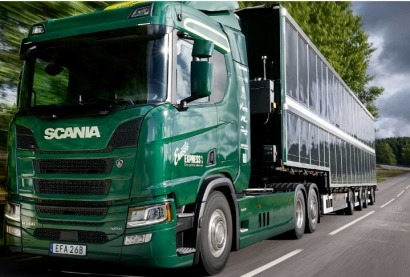
The truck is being used in a research project to examine the generated solar energy, and how much carbon emissions decrease via the solar panels. The researchers developed new, efficient, and lightweight solar panels for trucks. They also study how trucks can interact with the power grid, and bring forward new models for what will happen if several trucks like this one are connected to the power grid
“Scania’s purpose is to drive the shift towards a sustainable transport system” said Stas Krupenia, Head of the Research Office at Scania. “Never before have solar panels been used to generate energy to a truck’s powertrain like we do in this collaboration. This natural energy source can significantly decrease emissions in the transport sector. It is great to be at the forefront in the development of the next generation’s trucks.”
The truck’s 18-metre trailer is almost completely covered in solar panels, equivalent to a house equipped with similarly powerful panels. The solar energy gives the hybrid truck a prolonged driving range of up to 5.000 kilometres annually in Sweden. In countries like Spain, with more sun hours, the vehicle can double the amount of solar energy and thus driving range compared to Swedish circumstances.
The project also includes research on new, lightweight tandem solar cells, that are based on a combination of Midsummer’s solar cells and new perovskite solar cells. These enable a higher efficiency in the transformation of sunlight to electricity. Such a solution could double the solar energy generation, compared to the current energy generated by the panels.
“This is an exciting project where academia and industry together try to decrease the climate impact from truck transports” added Erik Johansson, Project Manager and Professor of physical chemistry at Uppsala University. “The results from this unique truck will be very interesting. Our research towards efficient and light solar cells will be truly important, especially when it comes to applying them in future trucks.”
One part of the project was to evaluate the charging's impact on the electricity grid and whether it would be possible to sell the surplus. The possibility of two-way charging is not entirely straightforward and the legislation is unclear.
“We thought we would be able to buy the trucks surplus, unfortunately that is not possible at the moment” said Sverker Ericsson, Electrical Trade Engineer at Dalakraft. “But the solar cells becoming part of the truck's energy supply is fantastic. As an electricity trading company, we see that all renewable energy sources are needed to cope with the energy transition.”
The truck will now be tested by operating on public roads by the haulage company Ernsts Express AB.
The solar powered truck has been developed in a research project party funded by government agency of innovation Vinnova, to develop trucks with low climate impact thanks to solar energy. The truck is a 560 horsepower plug-in hybrid. On the 18-metre trailer, an area of 100 square metres is covered by thin, lightweight and flexible solar panels with a maximum efficiency of 13,2 kWp (kilowatt peak). They are estimated to deliver 8,000 kilowatt hour (kWh) annually when operated in Sweden. The batteries have a total capacity of 300 kWh, with 100 kWh on the truck and 200 kWh on the trailer.
For additional information:

